Pala, California facts for kids
Quick facts for kids
Pala
|
|
|---|---|
| San Antonio de Pala | |

|
|
| Country | United States |
| State | California |
| County | San Diego |
| Time zone | UTC-8 (Pacific (PST)) |
| • Summer (DST) | UTC-7 (PDT) |
| ZIP codes |
92059
|
| Area codes | 442/760 |
Pala is a small community in San Diego County, California. It is mostly home to Native American people. Pala is also known as a CDP, which is a special area the government uses for counting people. It is located within the Pala Indian Reservation.
For many centuries, Pala was a traditional meeting place for Native American tribes. In the early 1800s, Spanish Franciscan missionaries chose this spot. They built a mission here to teach Native Americans about their culture and religion.
Pala is north of Escondido, which is part of the San Diego-Carlsbad metro area. The community uses ZIP Code 92059 and area code 760. Pala is in the Pacific time zone and sits about 404 feet above sea level.
The name "Pala" might come from Native American languages. In the Cupeño or Luiseño languages, "pal" means "water." Another idea is that the name comes from the Spanish word pala, which means "shovel."
Gemstones of Pala
After the Mexican–American War, California became part of the United States. Pala then became famous for its valuable mineral resources, like gold and tourmaline. Many gem mines started operating in the 1890s. Today, more than twenty mines are listed in a special database called Mindat.
Pink Tourmaline
Gem mines in the Pala area still produce tourmaline. The pink type of tourmaline is especially well-known here.
A powerful leader in China, the Dowager Empress Cixi of the Qing Dynasty, loved the pink tourmaline from Pala. Because she wanted so much of it, the demand for this gem grew a lot after 1902. This caused a big boom in California's tourmaline mining business, especially at the Himalaya mine. However, after the Empress died in 1908, the demand for the gem went down around 1911.
Other Important Gems
Pala is also where a gem called morganite beryl was first found. In 1902, the first large amount of kunzite was discovered here. Kunzite was named after George Frederick Kunz, who was a very important expert in gems.
See also
 In Spanish: Pala (California) para niños
In Spanish: Pala (California) para niños



